Motion sickness in VR headsets happens because your brain receives conflicting sensory signals. When you’re wearing a headset, your eyes perceive virtual movement while your vestibular system detects that you’re actually stationary. This sensory mismatch confuses your brain’s navigation system, triggering nausea and discomfort. Technical factors like low refresh rates, high latency, and incorrect IPD settings worsen these symptoms. Your individual susceptibility varies based on age, gender, and previous VR experience. Understanding these underlying mechanisms can help you minimize discomfort.
The Science Behind Sensory Conflict in Virtual Environments
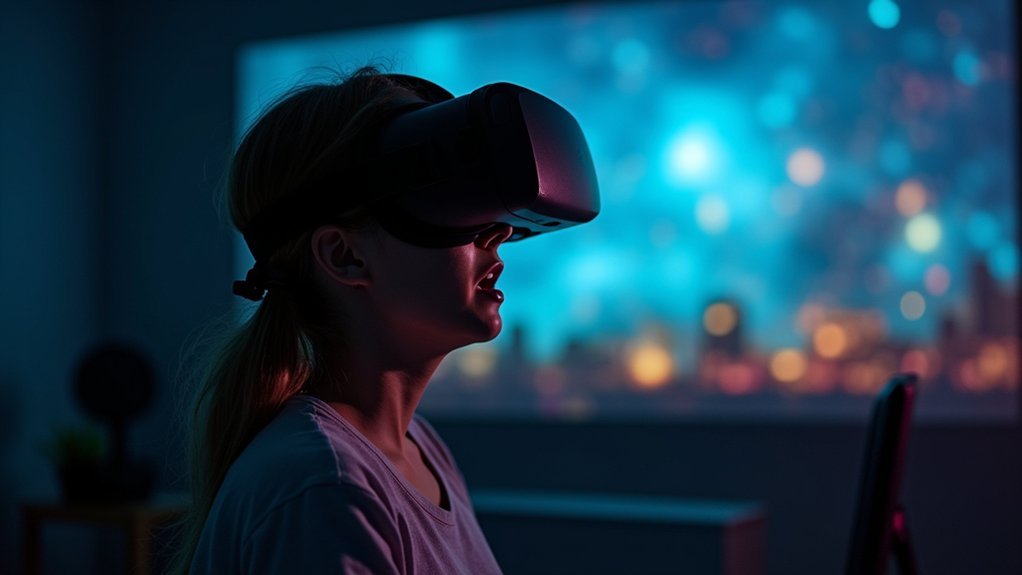
When you put on a VR headset, your brain expects your body’s movement sensors to align with what you’re seeing, but this doesn’t always happen. This creates sensory conflict, where visual input from the virtual environment contradicts vestibular signals from your inner ear.
Your vestibular system detects actual head movements and balance, while your eyes see virtual motion that doesn’t match reality. This disconnect confuses your brain’s navigation system, triggering motion sickness symptoms like nausea and dizziness.
Low refresh rates worsen this mismatch by creating lag between your head movements and visual updates. Individual susceptibility varies greatly – some people adapt quickly while others experience severe discomfort.
Understanding this sensory conflict helps explain why VR motion sickness affects users differently.
Technical Factors That Trigger Motion Sickness
While sensory conflict explains the biological basis of VR motion sickness, several technical aspects of headset design and performance directly influence how severely you’ll experience these symptoms.
| Technical Factor | Impact on Motion Sickness | Recommended Threshold |
|---|---|---|
| High latency | Creates movement delays causing sensory confusion | Under 20ms |
| Refresh rate | Low rates produce glitches and visual disruption | Minimum 90 Hz |
| Interpupillary distance | Incorrect settings cause 40% of cyber sickness cases | Properly calibrated per user |
Your visual perception suffers when these elements aren’t optimized. Limited field of view creates tunnel vision that disrupts spatial awareness, while laggy hand tracking provides unreliable sensory feedback. These technical shortcomings force your brain to work harder reconciling conflicting signals, amplifying motion sickness intensity.
Individual Susceptibility and Risk Factors
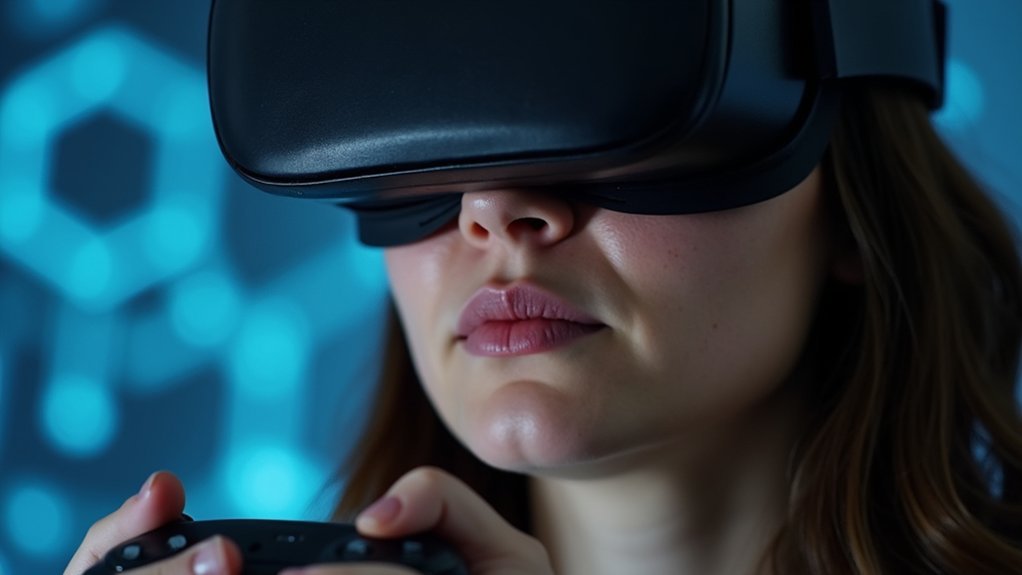
Your likelihood of experiencing motion sickness in VR headsets isn’t random—it’s tied to specific personal characteristics that make some people more vulnerable than others.
Age plays a vital role, with children under 13 facing higher risks due to their still-developing vestibular systems, while adults over 50 may also find themselves more susceptible.
Gender differences also emerge, as research shows women tend to experience VR motion sickness more frequently than men, though your individual response can vary regardless of these general patterns.
Age and Gender Factors
Gender and age greatly influence your likelihood of experiencing motion sickness in VR headsets. Women are more susceptible to VR motion sickness than men, largely due to hormonal differences that heighten sensitivity.
Certain ethnic groups, particularly Asian women, show increased vulnerability to these symptoms.
Age plays a critical role in your risk level. If you’re between 2 and 12 years old, you’ll face high susceptibility, though this decreases steadily until age 21.
However, if you’re 50 or older, your risk increases again due to age-related changes in vestibular function and visual processing.
Your personal health conditions greatly impact your VR experience. A history of motion sickness, migraines, or inner ear problems can substantially increase your likelihood of experiencing discomfort while using VR headsets.
Adaptation and Experience
Beyond these demographic and health-related risk factors, your ability to adapt to VR environments plays an equally important role in determining whether you’ll experience motion sickness. Familiarity with VR technology considerably reduces your susceptibility as you become accustomed to processing virtual sensory input.
Your brain learns to reconcile the disconnect between visual movement and physical stillness, making adaptation a powerful defense mechanism.
- Start small: Begin with shorter VR sessions in low-motion virtual environments to build tolerance gradually
- Practice regularly: Consistent exposure helps your brain adapt faster to VR’s unique sensory input patterns
- Build progressively: Gradually increase session length and motion intensity as your experience level grows
Gradual exposure proves most effective, allowing you to develop VR tolerance without overwhelming your sensory systems and triggering motion sickness symptoms.
Display Technology and Frame Rate Impact
The technical foundation of your VR headset directly determines whether you’ll experience smooth immersion or uncomfortable motion sickness. Your headset’s refresh rate must reach at least 90 Hz to prevent visual glitches that trigger nausea.
When frame rate drops below this threshold, you’ll notice motion lag that confuses your senses. High latency compounds these issues by creating delays between your head movements and visual updates, leading to sensory mismatch.
Your interpupillary distance settings are critical—incorrect visual alignment causes up to 40% of cyber sickness cases. A narrow field of view creates tunnel vision that disrupts your natural visual experience.
However, high-resolution displays exceeding 70 pixels per degree provide clearer visuals that enhance your immersive experience while reducing motion sickness symptoms through improved visual fidelity.
Comfort Settings and Calibration Options
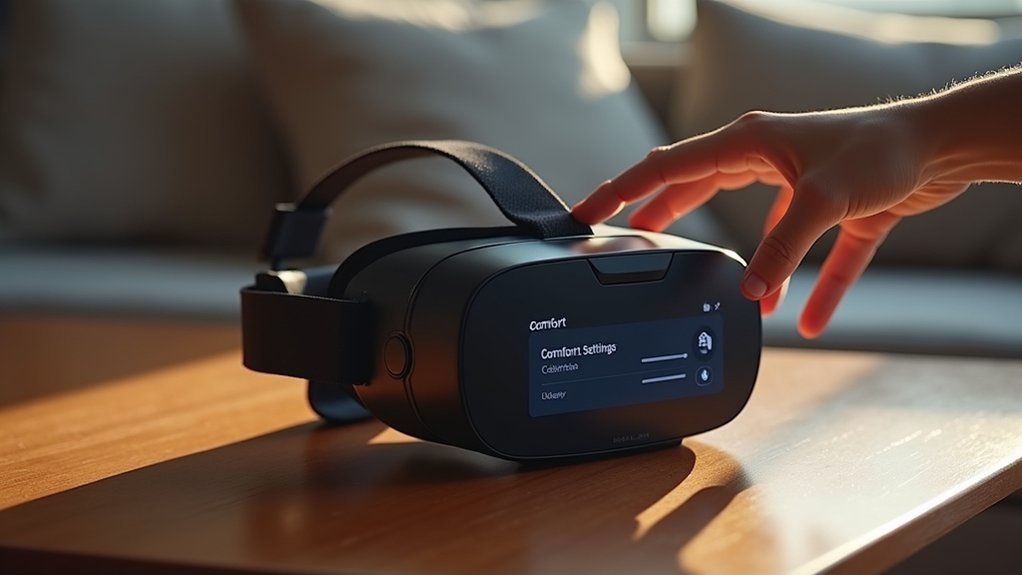
Five essential calibration adjustments can transform your uncomfortable VR experience into smooth, nausea-free immersion. Proper interpupillary distance calibration prevents up to 40% of motion sickness cases, while high-end VR headsets like the Varjo XR-4 offer automatic IPD adjustment for enhanced user experience.
You’ll reduce sensory overload by fine-tuning brightness and resolution settings to match your comfort levels.
Essential comfort settings include:
- IPD calibration – Guarantees proper visual alignment and reduces eye strain
- Movement speed limitations – Prevents overwhelming locomotion that triggers nausea
- Brightness adjustment – Minimizes visual fatigue during extended sessions
A snug headset fit eliminates unwanted movement while customizable locomotion techniques let you tailor experiences to your tolerance.
These calibration options work together to create comfortable, immersive sessions without motion sickness symptoms.
Movement Design and User Experience Considerations
While proper calibration sets the foundation for comfort, thoughtful movement design determines whether you’ll enjoy smooth exploration or suffer from debilitating nausea. Your VR headset’s refresh rate and latency directly impact motion sickness – you’ll need at least 90 Hz refresh rates and systems that reduce latency below 20 milliseconds for comfortable experiences.
Smart locomotion techniques like teleportation and snap turning give you predictable movement options that prevent conflicts between visual and vestibular inputs. When developers design experiences with rapid or unpredictable movements, users experience increased discomfort.
Your field of view also matters – wider FOVs enhance immersion but require proper calibration to avoid symptoms.
Start with minimal movement experiences and practice gradual adaptation. This approach helps you build tolerance while movement design considerations protect your comfort throughout VR sessions.
Hardware Solutions for Motion Sickness Prevention
Beyond software optimizations, your headset’s hardware specifications directly determine how well it prevents motion sickness before symptoms can develop. High refresh rates at 90 Hz guarantee smoother visuals that synchronize perfectly with your head movements, eliminating the jarring disconnects that trigger nausea. Low latency under 20 milliseconds creates seamless responsiveness between your physical actions and visual feedback.
Key hardware features that enhance user comfort include:
- Automatic IPD adjustment – tailors the visual experience to your unique eye spacing, preventing visual discomfort
- High-resolution displays exceeding 70 pixels per degree – deliver crystal-clear imagery that reduces eye strain
- Advanced hand tracking – provides stable reference points for better spatial orientation
These specifications work together to create an immersive experience that feels natural rather than disorienting.
Gradual Adaptation Strategies for New Users
You can build tolerance to VR motion sickness by starting with brief 5-minute sessions and gradually extending them to 15 minutes over several weeks.
Your initial experiences should focus on stationary or minimal-movement content, as 3DOF environments cause considerably less disorientation than dynamic simulations.
This measured approach lets your vestibular system adapt naturally without overwhelming your senses during the critical adjustment period.
Start With Short Sessions
When you’re new to virtual reality, starting with brief sessions of 5 to 10 minutes helps your brain gradually adapt to the unfamiliar sensory environment without overwhelming your system.
Short sessions allow new VR users to acclimate without triggering severe motion sickness symptoms that could discourage future use.
As you build comfort over several weeks, you can gradually extend your sessions up to 15 minutes. This incremental approach lets your brain adjust to the sensory conflicts that VR creates between what you see and what your inner ear feels.
- Take immediate breaks when you feel any discomfort to prevent symptoms from escalating
- Sit down during sessions to enhance postural stability and reduce motion sickness risk
- Increase duration slowly over weeks rather than jumping to longer sessions too quickly
Choose Low-Movement Content
Starting with stationary VR experiences like virtual museums, meditation apps, or simple puzzle games greatly reduces your motion sickness risk because these environments minimize the sensory conflicts that trigger nausea.
These low-movement VR experiences allow your brain to process visual inputs without overwhelming your vestibular system. You’ll want to choose 3DoF content that limits movement to head rotation rather than full locomotion through virtual spaces.
As you become comfortable with stationary experiences, you can gradually introduce slightly more dynamic content. This approach helps you acclimate to virtual environments systematically.
Remember to take immediate breaks if you feel any discomfort during these sessions. Your brain needs time to adapt to the unique sensory conflict patterns that VR creates, and rushing this process often backfires.
Frequently Asked Questions
Why Does VR Headset Give Me Motion Sickness?
Your VR headset creates motion sickness because your eyes see movement while your inner ear senses you’re stationary. This sensory mismatch confuses your brain, triggering nausea and dizziness as conflicting signals clash.
How to Avoid Motion Sickness in VR?
Start with short 5-10 minute sessions, choose smooth movement experiences, use high-quality headsets with 90Hz refresh rates, take regular breaks, stay hydrated, and avoid heavy meals beforehand.
Can Headsets Make You Sick?
Yes, headsets can make you sick. You’ll experience nausea, dizziness, and discomfort when there’s a mismatch between what you’re seeing and what your body’s feeling during virtual reality use.
What Is the Best VR Headset to Avoid Motion Sickness?
You’ll find Varjo XR-4 and VR-3 headsets are excellent choices for avoiding motion sickness. They feature automatic IPD adjustment, 90Hz refresh rates, under 20ms latency, and high resolution exceeding 70 pixels per degree.


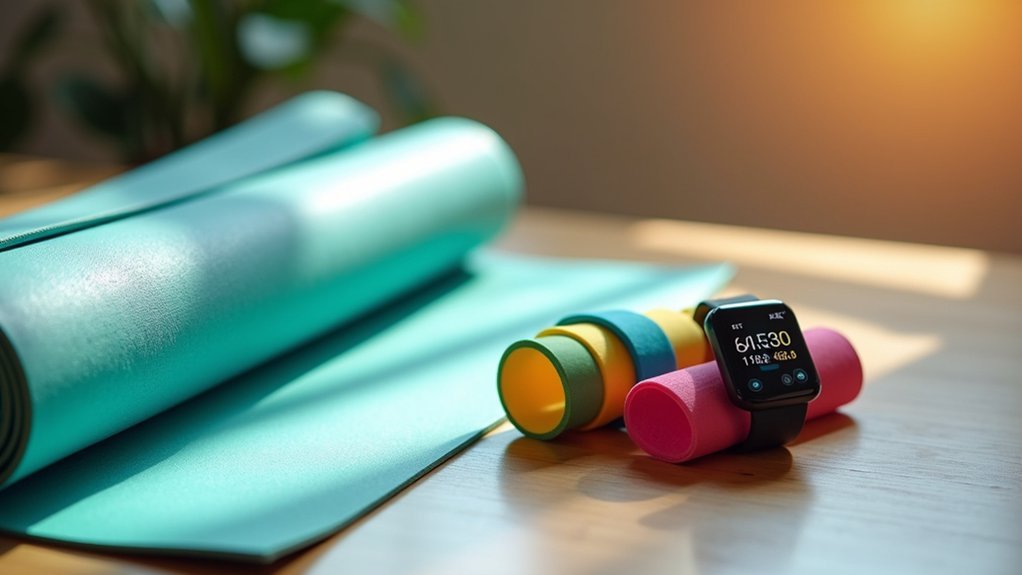
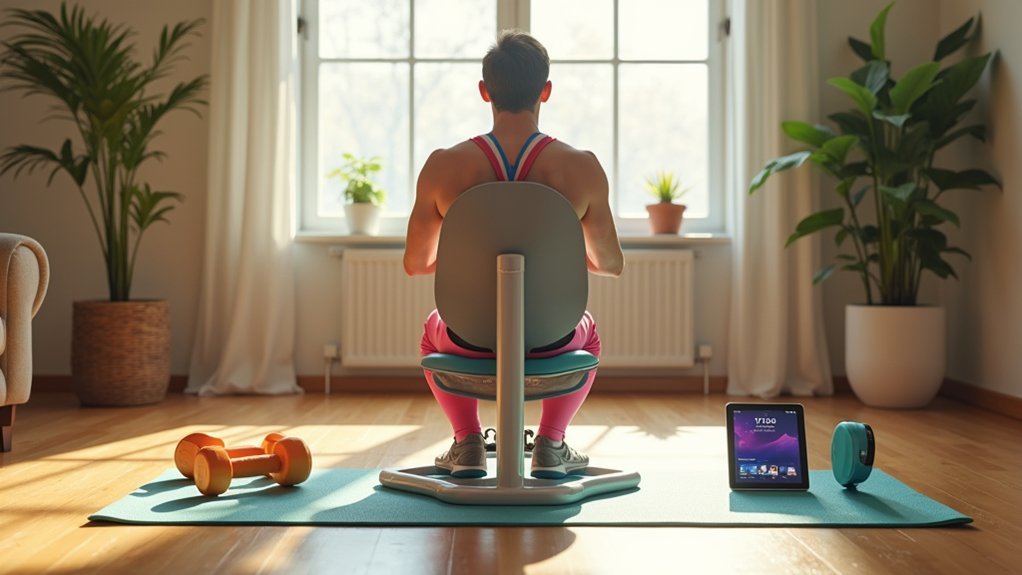

Leave a Reply